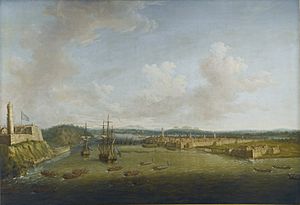Gutierre de Hevia facts for kids
Quick facts for kids
The Most Excellent
Gutierre de Hevia y Valdés, Marqués del Real Transporte
|
|
|---|---|

Fall of Havana, 1762; de Hevia was court-martialled for his role in its capture
|
|
| Commandant General of Spanish Marine Infantry | |
| In office 1759–1772 |
|
| Personal details | |
| Born | 1704 Tortona, Piedmont |
| Died | 2 December 1772 (aged 68) Cadiz, Spain |
| Spouses | Rosalía Navarro y Gauset, II Marquesa de la Victoria |
| Children | María Lutgarda de Hevia y Navarro (1758-1837) |
| Military service | |
| Rank | Admiral |
| Battles/wars | |
Gutierre de Hevia y Valdés (born 1704, died December 2, 1772) was an important Spanish naval officer. He became an Admiral, which is a very high rank in the navy. He also led the Spanish Marine Infantry, a special group of soldiers who serve on ships.
Hevia was put on trial by a military court, called a court-martial, because of what happened when Havana was captured in 1762. But he was later given back his titles and position.
Contents
Gutierre de Hevia y Valdés was born in Tortona, which is in Italy. He joined the Spanish Navy in 1720 when he was about 16 years old.
While in Cadiz, Spain, he was involved in an incident where another person died. He faced a trial but was found innocent. After this, he moved to the Americas.
He quickly showed his bravery. In 1732, during the recapture of Oran, he was one of the first three soldiers to step onto enemy land. This was a very daring act!
Key Battles and Promotions
During the War of Jenkins' Ear in 1741, Hevia helped defend Cartagena de Indias successfully. This was an important battle where the Spanish forces protected their city.
In 1747, he received his first command, leading a warship called Nueva España. This was a big step in his career.
A few years later, in 1759, Hevia commanded the ship Fenix. This ship was part of a group of ships that brought the new king, Charles III of Spain, from Naples to Spain. For this important service, Hevia received special titles: Marqués del Real Transporte and Vizconde del Buen Viaje. He was also promoted to Capitán de navío and officially became the leader of the Spanish Marine Infantry.
The Siege of Havana
In 1761, Spain joined the Seven Years' War on the side of France. Because of this, Hevia and his fleet of 12 ships were sent to Havana, Cuba. Their mission was to protect the city from an attack by the British.
On June 6, 1762, a strong British invasion force, led by the Earl of Albemarle, began the Siege of Havana. During this siege, Hevia's ships did not fight at sea. Instead, all their cannons and sailors were moved onto land to help defend the forts.
On August 13, the city was captured by the British. Hevia had not burned his fleet of ships, so the British took all of them.
Court-Martial and Later Life
After Havana was captured, Hevia and the Spanish sailors who survived were sent back to Spain. When he arrived, the government in Madrid held a court-martial for him. A court-martial is a military trial.
Hevia was found guilty and lost his titles. He was also ordered to stay under house arrest for 10 years. However, his father-in-law, Juan José Navarro, was a very important naval officer. Thanks to his influence, Hevia was pardoned on September 17, 1765. This pardon happened during the wedding celebrations of Charles, the Prince of Asturia. Hevia got his titles back and was reinstated in his previous positions.
Gutierre de Hevia y Valdés died on December 2, 1772, in Isla de León, Spain.
See also
 In Spanish: Gutierre de Hevia para niños
In Spanish: Gutierre de Hevia para niños

